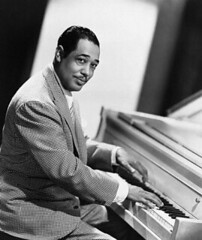Edward Kennedy Ellington was born on April 29, 1899 to James Edward Ellington and Daisy Kennedy Ellington.
J.E. made blueprints for the United States Navy. He also worked as a butler for Dr. Middleton F. Cuthbert, a prominent white physician, and occasionally worked as a White House caterer.[9] Daisy and J.E. were both piano players—she played parlor songs and he operatic airs.
At the age of seven, Ellington began taking piano lessons from Marietta Clinkscales.[10] Daisy surrounded her son with dignified women to reinforce his manners and teach him to live elegantly.
Ellington’s childhood friends noticed that "his casual, offhand manner, his easy grace, and his dapper dress gave him the bearing of a young nobleman",[11] and began calling him Duke.
From 1917 through 1919, Ellington launched his musical career, painting commercial signs by day and playing piano by night. Ellington moved out of his parents' home and bought his own as he became a successful pianist.
Ellington played throughout the Washington, D.C. area and into Virginia for private society balls and embassy parties. The band thrived, performing for both African-American and white audiences, a rarity during the racially divided times.
In June 1923, a gig in Atlantic City, New Jersey led to a play date at the prestigious Exclusive Club in Harlem, followed in September 1923 by a move to the Hollywood Club, 49th and Broadway, and a four-year engagement, which gave Ellington a solid artistic base.
In 1925, Ellington contributed four songs to Chocolate Kiddies, an all-African-American revue which introduced European audiences to African-American styles and performers. "Duke Ellington and his Kentucky Club Orchestra" grew to a ten-piece organization, developing their distinct sound, displaying the non-traditional expression of Ellington’s arrangements, the street rhythms of Harlem, and the exotic-sounding trombone growls and wah-wahs, high-squealing trumpets, and sultry saxophone blues licks of the band members.
In 1927 Harlem's Cotton Club offered a weekly radio broadcast and famous white clientèle nightly pouring in to see the latest. Ellington and his band thrived in the period from 1932 to 1942, a "golden age" for the band.
In 1927 Ellington made a career-advancing agreement with agent-publisher Irving Mills giving Mills a 45% interest in Ellington's future.[20] Mills had an eye for new talent and early on published compositions by Hoagy Carmichael, Dorothy Fields, and Harold Arlen. During the 1930s, Ellington's popularity continued to increase, largely as a result of the promotional skills of Mills, who got more than his fair share of co-composer credits. Mills arranged recording sessions on the Brunswick, Victor, and Columbia labels which gave Ellington popular recognition. Mills took the management burden off of Ellington's shoulders, allowing him to focus on his band's sound and his compositions.
At the Cotton Club, Ellington's group performed all the music for the revues, which mixed comedy, dance numbers, vaudeville, burlesque, music, and illegal alcohol.
In 1929, Ellington appeared in his first movie, a nineteen-minute all-African-American RKO short, Black and Tan, in which he played the hero "Duke". In the same year, The Cotton Club Orchestra appeared on stage for several months in Florenz Ziegfeld's Show Girl, along with vaudeville stars Jimmy Durante, Eddie Foy, Jr., Al Jolson, Ruby Keeler, and with music and lyrics by George Gershwin and Gus Kahn.
As the Depression worsened, the recording industry was in crisis, dropping over 90% of its artists by 1933.[22] Ellington and his orchestra survived the hard times by taking to the road in a series of tours. Radio exposure also helped maintain popularity. Ivie Anderson was hired as their featured vocalist.
Ellington led the orchestra by conducting from the keyboard using piano cues and visual gestures; very rarely did he conduct using a baton. As a bandleader, Ellington was not a strict disciplinarian but he maintained control of his orchestra with a crafty combination of charm, humor, flattery, and astute psychology. A complex, private person, he revealed his feelings to only his closest intimates and effectively used his public persona to deflect attention away from himself.
While their United States audience remained mainly African-American in this period, the Cotton Club had a near exclusive white clientèle and the band had a huge following overseas, demonstrated both in a trip to England in 1933 and a 1934 visit to the European mainland.
On their tour through the segregated South in 1934, they avoided some of the traveling difficulties of African-Americans by touring in private railcars, which provided easy accommodations, dining, and storage for equipment, while avoiding the indignities of segregated facilities.
Ellington delivered some huge hits during the 1930s, which greatly helped to build his overall reputation. Some of them include: "Mood Indigo" (1930), "It Don't Mean a Thing (If It Ain't Got That Swing)" (1932), "Sophisticated Lady" (1933), "Solitude" (1934), "In a Sentimental Mood" (1935), "Caravan" (1937), "I Let A Song Go Out Of My Heart" (1938). "Take the "A" Train" which hit big in 1941, was written by Billy Strayhorn.
The band reached a creative peak in the early 1940s, when Ellington wrote for an orchestra of distinctive voices and displayed tremendous creativity.
Meanwhile, the development of modern jazz, or bebop, the music industry's shift to solo vocalists such as the young Frank Sinatra as the Big Band era receded. Bebop rebelled against commercial jazz, dancing to jazz, and strict forms to become the music of jazz aficionados. Furthermore, by 1950 the emerging African-American popular music style known as Rhythm and Blues drew away the young African-American audience and Rock & Roll soon followed. In the face of these major social shifts, Ellington continued on his own course.
Wednesday, December 2, 2009
Subscribe to:
Post Comments (Atom)





No comments:
Post a Comment